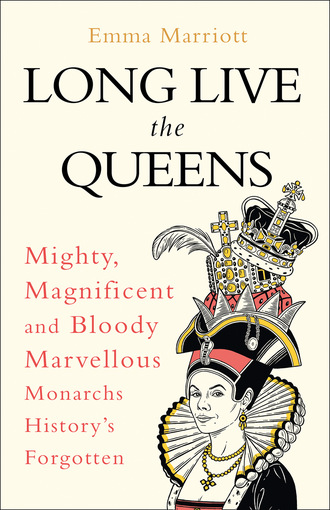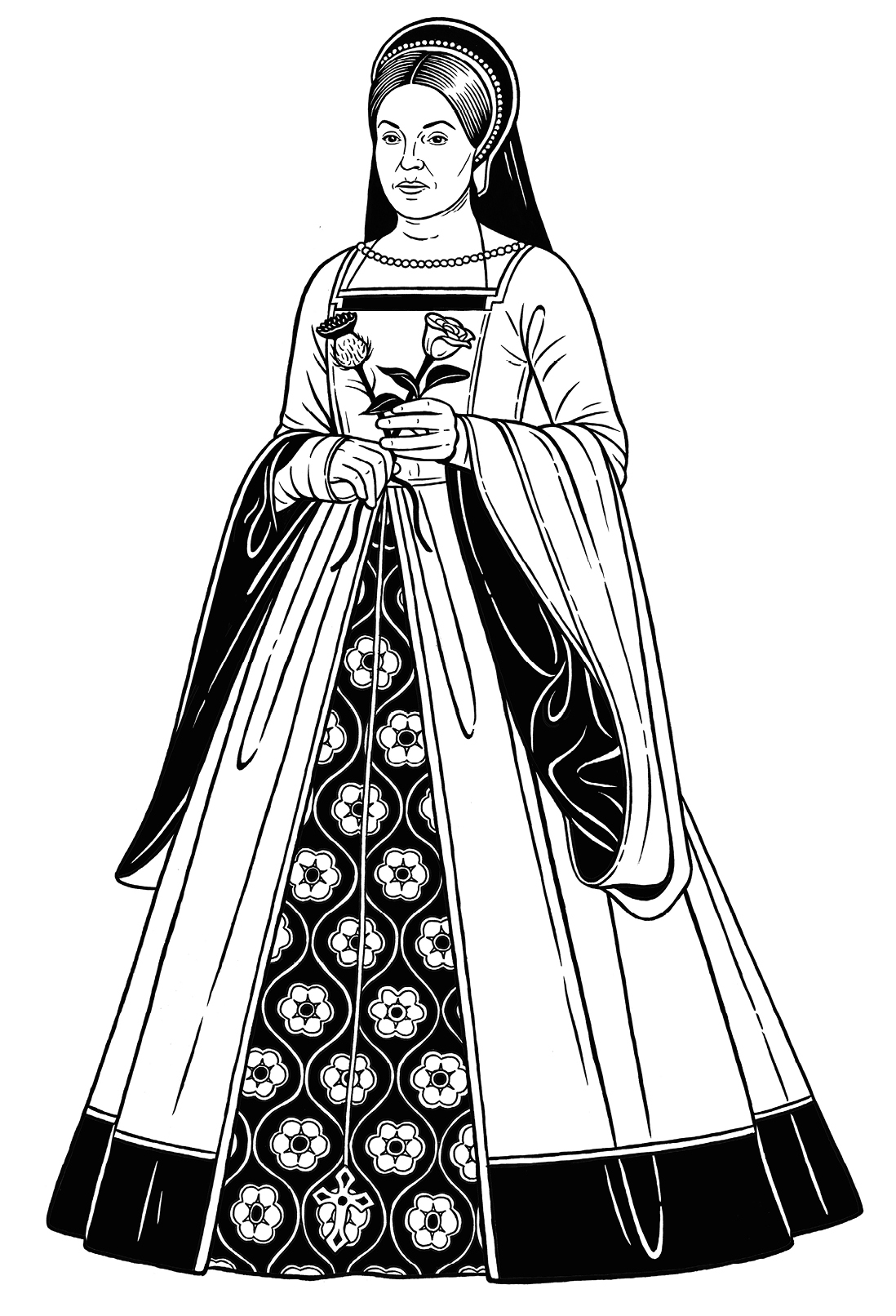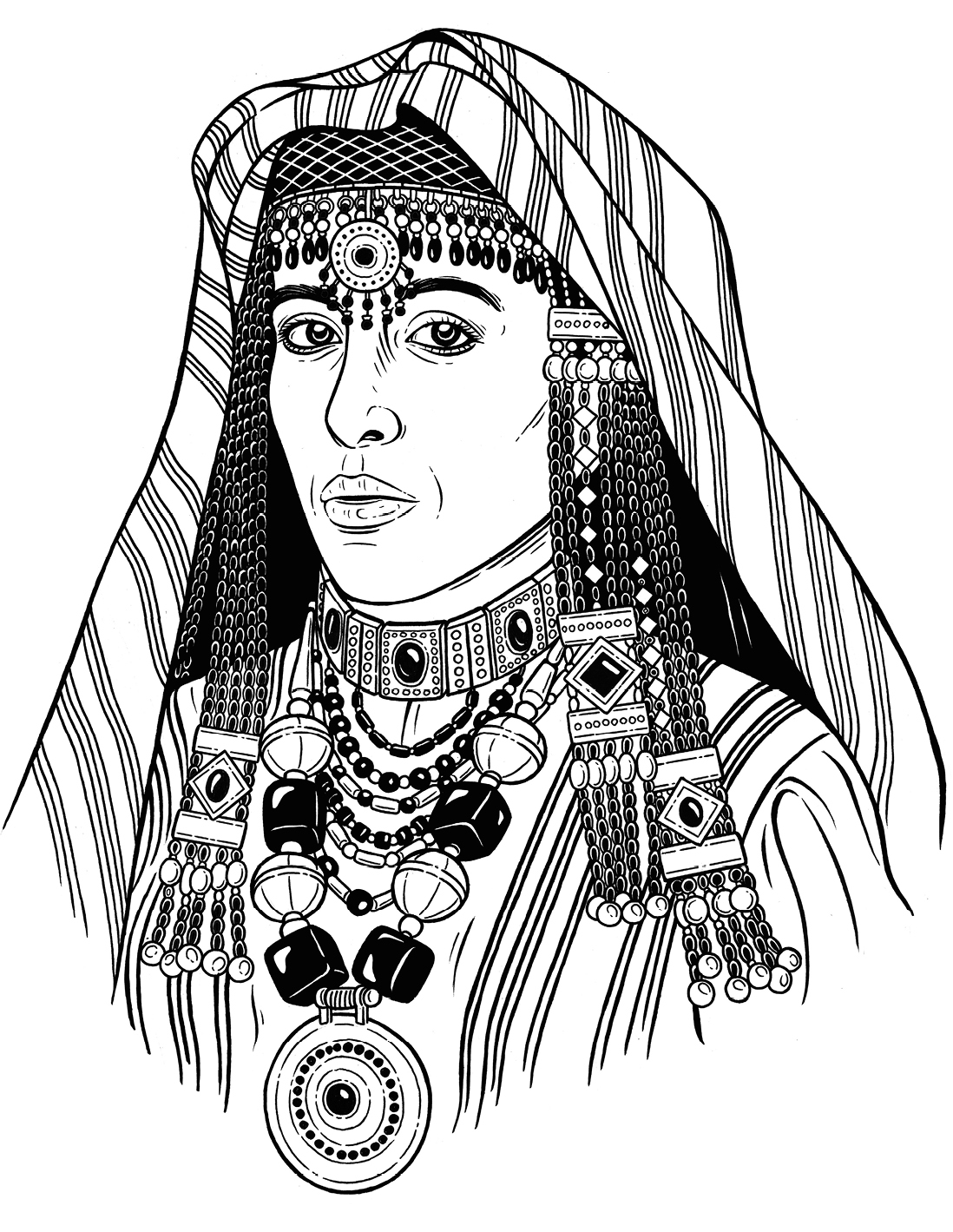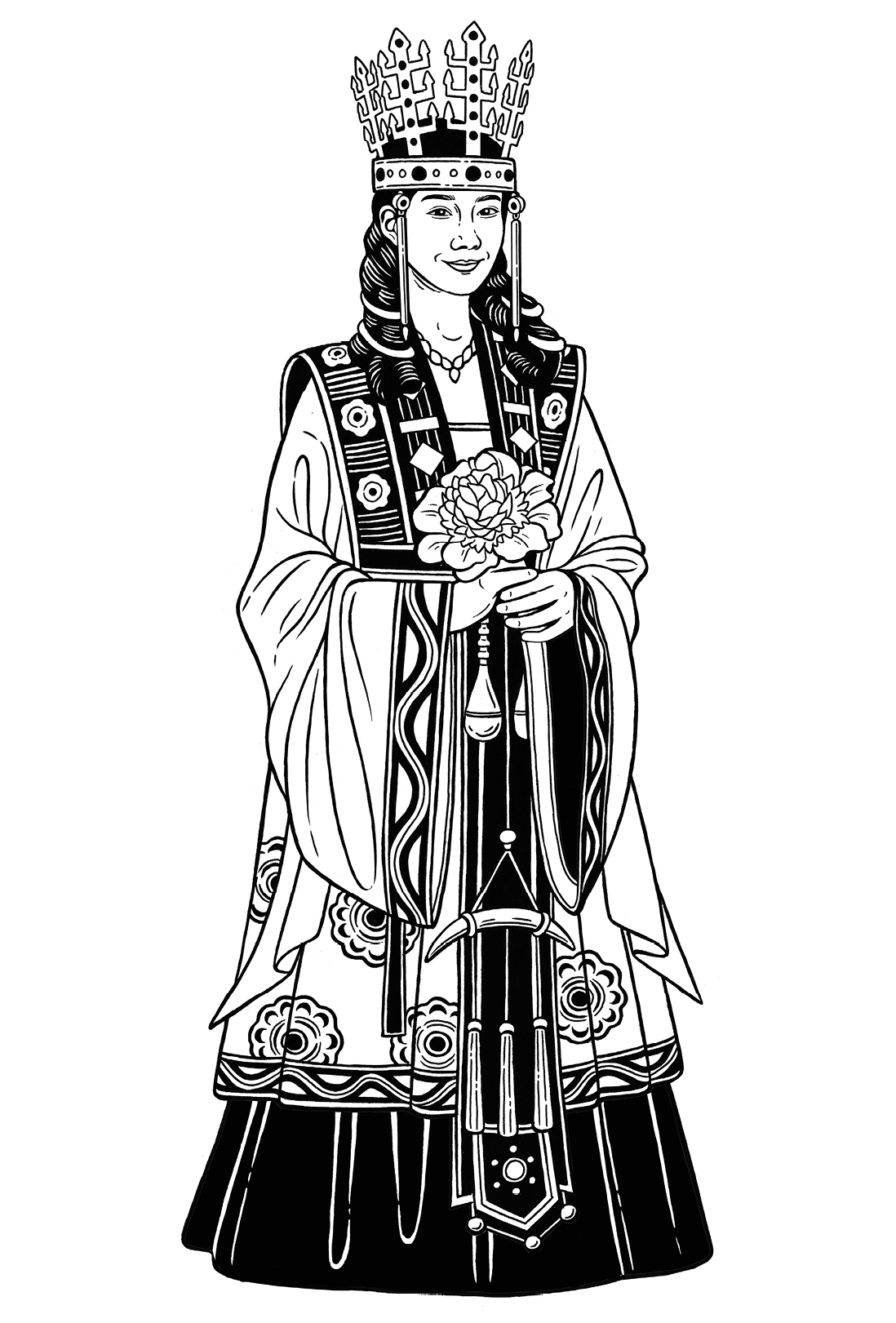
Полная версия
Long Live the Queens
As Empress, Wu set about removing officials who were opposed to her elevated status on the grounds that she was not of an aristocratic background and as a former concubine of Taizong, her relationship with Gaozong was incestuous. In 660, Gaozong suffered a stroke – although some historians have claimed that Wu Zetian poisoned him – and he remained in poor health for the rest of his life. Wu in effect took charge and continued exiling and executing potential rivals, some from her own family, including possibly her sister and brothers, her teenage niece, who had caught Gaozong’s eye, and Wu’s eldest son Li Hong, who in 675 died suspiciously, some believing that he was poisoned by the Empress.
When it came to her innermost circle, Wu clearly maintained a reign of terror, but her responsibilities also lay with the vast empire of China and the 50 million people who lived on its mountains, lush fields and everywhere in between. Wu did this with real efficiency, employing bureaucratic officials largely based on talent rather than social standing, and increasing the number of government posts filled by civil servants and scholars, who were required to pass a rigorous exam, rather than by those of noble birth. Her government helped to stabilise the Tang Empire, previously torn apart by civil war and under threat from ethic groups in the north and west, and under her aegis the empire was relatively fertile and prosperous. Between 655 and 675, military leaders that were chosen by Wu also conquered Korea, which considerably expanded the influence of the Chinese state, and she welcomed ambassadors from as far away as the Byzantine Empire.
In 683 Gaozong died and was succeeded by his and Wu’s son, Li Xian, known as the Zhongzong Emperor. He was married to a woman who tried to exert as much influence over Li Xian as Wu herself, which led to Wu swiftly deposing and exiling Li Xian and installing her second son, Li Dan, in 684, although his rule was largely nominal and she continued to govern in his stead. Crushing a rebellion in the south by a loyal army, Wu also maintained an efficient secret police, installing a series of copper boxes in the capital in which citizens could post anonymous denunciations of one another.
In 690, Wu took the ultimate step: at the age of sixty-five she usurped the throne itself and declared herself Empress Regnant of the newly declared ‘Zhou Dynasty’, moving the capital to Luoyang in the west of Henan province. As the traditional Chinese order of succession normally barred women from ascending the throne, Wu was determined to sweep away all opposition and continued making use of the secret police. She also took steps to elevate the status of Buddhism as the favoured state religion, over that of Taoism and Confucianism, which had strongly held views against female rule. She ordered every district to set up a Buddhist temple and instigated various visual representations of the Buddha, adding to those built at the grottoes at Longmen near Luoyang – where there is a colossal statue called the Grand Vairocana Buddha, which is believed to have been carved in Wu’s own likeness.
In the last years of her life, Wu made two young courtiers, the Zhang brothers, her favourites at court in return for their devotion and elaborate entertainments, some say in the bedchamber, despite Wu being in her seventies. The brothers were increasingly resented by the court and senior officials. In 705, when she was eighty years old, a group of ministers seized the palace, executed the Zhang brothers and forced Wu to give up power to her son Zhongzong, who ruled as Emperor for another five years. Wu, who was already ill, retired to another palace and died at the end of 705.
Wu Zetian was clearly ruthless, killing off large numbers of officials and her own family, as did other (male) emperors before and after her – intense rivalries at court underpinned the imperial system. As a female, she could only secure power through guile and sheer determination and, in the face of fierce opposition, maintain her power through the ruthless elimination of anyone who stood in her way. And yet she was a competent ruler, controlling a large and widespread bureaucracy, and one of the most powerful champions of Buddhism in China. Had she been a man, she could well have been considered a great emperor and not, as one contemporary described her, ‘with a heart like a serpent and a nature like that of a wolf’. At the very least, her memorial tablet deserves some kind of inscription, although her name and her supposed wicked deeds have lived on regardless.

Margaret Tudor

Born: 1489
Died: 1541
Margaret Tudor, Scots queen and wife to King James IV, is very much a forgotten queen, upstaged by her younger brother, King Henry VIII, and even her own grand-daughter, Mary Queen of Scots. Widowed as a young woman, her life was beset by unwise marriages and her tenure as Queen was fraught with political intrigue and shifting alliances. Her role as Scottish monarch, however, marked the first step towards the union of England and Scotland, where she would rule as Queen, in one way or another, for three decades.
Discussions over the future marriage of Margaret Tudor began early in her life. The daughter of King Henry VII and Elizabeth of York, she was one of four children: Arthur was the eldest, followed by Margaret, Henry and Mary. As the eldest daughter, she would have been primed for marriage, one that would enhance and secure the status of Tudors as monarchs of England. Even before her sixth birthday, her father had put forward the idea of King James IV of Scotland as a suitable partner, largely as a means to reduce Scottish support for the Yorkist pretender to his throne, Perkin Warbeck. Henry may also have seen it as a step towards uniting the thrones, dismissing objections amongst the royal council that the match would put the Stewarts directly into the line of English succession (which indeed would happen just over a century later). Scotland was also in need of a queen for James IV, who was in his late twenties and not yet married, although by 1502 and the signing of the ‘Treaty of Perpetual Peace’ (which agreed the marriage between James and Margaret and an ending to hostilities between Scotland and England), the King had fathered several illegitimate children.
After a proxy marriage (popular amongst royals to seal the deal without the individuals involved actually having to be present), Margaret, then thirteen, made a grand journey northward to Scotland to join her new husband. Splendidly dressed, she met local dignitaries along the way, her father keen to demonstrate the power and opulence of the Tudor dynasty across his realm. In August 1503, James and Margaret celebrated their marriage in person at Holyrood Abbey in Edinburgh, the couple wearing matching white damask outfits, after which they attended extravagant festivities. The King appeared attentive to his young redhaired wife, even shaving off his beard after the wedding at her request. Whilst he was never faithful to his queen, James provided Margaret with lavish accommodation and she was clothed in rich furs and jewels. At sixteen, Margaret conceived a child, who died in infancy, as did another two children. Her first surviving son, James, was born in 1512, followed by Alexander in 1514 (although he would die a year later).
The couple would share a love of music and dancing and they presided over a cultured court; the King spoke multiple languages and had a wide interest in a variety of subjects from history to surgery and medicine. Foreign affairs, however, proved more troublesome, and the peace between Scotland and England not quite so perpetual when Margaret’s brother Henry VIII declared war on France and the French King, Louis XII, requested help from his Scottish ally. As a result, in 1513 James IV led an army south and invaded England, which culminated in a heavy Scottish defeat at the Battle of Flodden in which 10,000 Scots lost their lives, along with James himself. (Henry’s VIII’s wife, Catherine of Aragon, was actually English regent at the time of the battle and rejoiced in the Scottish defeat, even sending to Henry the Scottish King’s banner and bloody coat as trophies.) The infant James V was crowned three weeks later and, as was stipulated in the King’s will, Margaret became regent with the proviso that she remained unmarried.
Aged twenty-three, pregnant with Alexander and ruling over a country that had just lost its king and a huge number of men, all at the hands of her brother and sister-in-law, Margaret’s role as regent must have seemed fraught with difficulty. A pro-French faction took shape at Parliament, urging that Margaret be replaced by the French-born uncle of James V, John Stewart, Duke of Albany. For just over a year, she deftly managed to fend off the rival factions around her whilst maintaining a tenuous peace with her home country. In seeking allies, however, she would end up making the mistake of falling for the pro-England Archibald Douglas, Earl of Angus (described by his own uncle as a ‘young, witless fool’), whom she secretly married. In doing so, she forfeited the regency and Parliament appointed the Duke of Albany in her stead in September 1514. Margaret headed to Stirling Castle, where she was forced to hand her two sons over into the care of their uncle.
Now pregnant with the Earl of Angus’s child, she escaped to England, and in Harbottle Castle in Northumberland she gave birth to Margaret Douglas; two months later, in December 1515, she learned of the death of her second son, Alexander. Angus, showing his true colours, fled back to Scotland, leaving Margaret to head to the protection of her brother Henry in London. She returned to Scotland in 1517 to discover that Angus had rekindled a relationship with Lady Jane Stewart, with whom he’d had an illegitimate child, all the while living on Margaret’s dower income. Margaret was rightly outraged and mooted divorce to her brother, although Henry was opposed to it (which was a bit rich coming from him), and in angered response Margaret allied herself more closely with the Albany faction.
The Duke of Albany, who had been in France for three years, returned to Scotland in November 1521 and both he and Margaret actively sided against Angus. This lasted until 1524, when Margaret organised a coup d’état and ousted Albany, restoring twelve-year-old James to the throne, with Margaret formally recognised as the chief councillor to the King. Still desperately wanting a divorce from Angus, she ordered cannon guns to fire on him when he appeared in Edinburgh with a large group of armed men. Angus (sadly) managed to dodge the cannon balls and ended up in control of the King, whom he kept a virtual prisoner for three years.
In 1527, Margaret was finally granted a divorce by the Pope, after which she married a member of her household, Henry Stewart, later titled Lord Methven. When James assumed the full role as King in 1528, Margaret and Methven would act as close advisors to him, although by 1534 she fell out of favour with her son when she was discovered betraying state secrets to her brother, Henry. All was not well with her marriage either, as Methven proved equally partial to cavorting with other women and spending Margaret’s money. She would eventually reconcile with Methven and in 1538 form a close bond with her new daughter-in-law, the French queen consort of James V, Marie de Guise, before dying of a stroke in 1541 at Methven Castle in Perthshire.
Margaret Tudor’s tenure as Scottish Queen was turbulent and her life was made all the more difficult by the loss of James IV and her subsequent marriages to unscrupulous men. Throughout it all she tried to bring about a better understanding between long-time enemies England and Scotland, and no doubt would have whooped with delight at the eventual union of the Scottish and English crowns under her great-grandson, King James VI and I.

Arwa al-Sulayhi

Born: circa 1048
Died: 1138
Arwa al-Sulayhi was a long-reigning and powerful queen of Yemen. She was affectionally called by her many supporters the ‘Little Queen of Sheba’, as some claimed her throne was even greater than the biblical Queen of Sheba, who was thought to rule the kingdom of Saba in Yemen. She and her aunt before her were respected as sovereign rulers of the Sulayhid dynasty, and for the first time in Arab-Muslim history khutba prayers in mosques were proclaimed in their names, a privilege traditionally given only to monarchs. Arwa occupies a unique place in Islamic history, not only because she was a female ruler but also because her reign brought prosperity and stability to Yemen. And yet few know of her rule or even her name, her memory consigned to that now hefty file of forgotten queens.
Orphaned at a very young age, Arwa was brought up by her uncle, Ali al-Sulayhi, the then ruler of Yemen, and her aunt, Asma bint Shihab, in the palace of the Yemeni capital Sana’a. Ali, who had ruled since 1047, had named Asma ‘malika’ (queen) and formally acknowledged her as co-ruler, and her name was proclaimed in mosques alongside her husbands in the khutba. As a result, Asma attended council meetings and the King regularly sought her counsel and consulted with her over state business. Growing up alongside her cousin, Ahmad-al Mukarram, Arwa was groomed to be Queen. At the age of seventeen, she married al-Mukarram (cousins as marital partners are a popular choice for royal families wherever you are in the world). The bride received the principality of Aden as her dowry, after which she took charge of its management, appointing governors and overseeing collection of its taxes.
In 1067, King Ali and Queen Asma took a pilgrimage to Mecca. On the way there, their large caravan stopped for a night at an oasis. Suddenly they were attacked by their Ethiopian enemy, Sa’id ibn Najah, the Prince of Zabid. Ali was killed, his 5,000 accompanying soldiers were persuaded to join Sai’id, and Asma was taken to a secret prison in Zabid. There, it was said that the severed head of the King was placed on a pole where his widow could see it from her cell. After a year’s imprisonment, Asma managed to get a message to al-Mukarram. Notables in Sana’a immediately rallied in support of al-Mukarram ‘to save the honour of the Queen’. Three thousand horsemen rode to Zabid and succeeded in routing the 20,000 Ethiopians defending the city, and al-Mukarram rushed to the prison where his mother was being held.
Still wearing his helmet, he arrived at the door of Asma’s cell, announced who he was and asked if he could enter. With his face masked, however, the Queen was suspicious and it was only when he took his helmet off that she could see it was her son and immediately greeted him as the King. It was said that al-Mukarram was so shocked, both at seeing his mother alive and being named as King, that he suffered partial and permanent paralysis.
Both mother and son returned to Sana’a, al-Mukarram was invested as King but Asma acted as the effective regent as al-Mukarram was now largely bed-ridden. Asma also brought in her aunt Arwa to help with affairs of state, which she did for another two decades. In 1087, Asma died, al-Mukarram had largely removed himself from public life and Arwa was acknowledged as co-regent. She became known as Sayyida-al Hurra (meaning ‘noble queen’) – the same title given to another much-admired Moroccan queen of the 1500s (see Sayyida al-Hurra).
As ruler, Arwa set upon reasserting the might of the Sulayhid dynasty and to avenge her father-in-law’s death. She moved the capital from Sana’a to the mountainous fortress city of Jabala, installing al-Mukarram there along with her treasure. Near to Jabala she managed to crush the army of Sa’id ibn Najah, having lured their leader to Jabala under the pretext that her allies were about to abandon her, whereas they were in fact lying in wait for the Ethiopians. Sai’d was killed and his wife Umm al-Mu’arik was imprisoned. Arwa then ordered that Sai’d’s decapitated head be placed on a pole just outside his wife’s cell, mirroring the punishment meted out to her aunt and uncle – proving that queens can be just as vindictive as their male counterparts.
Over the next few years Arwa began a series of conquests in an attempt to expand her territories. In 1091, al-Mukarram died, and she was encouraged by the Fatimid caliphate in Cairo (with whom the Sulayhid dynasty were allied) to marry her late husband’s cousin Saba ibn Ahmad. Sources are conflicted on the marriage; some say she was reluctant to marry him and only did so to remain in power. Whether or not the marriage was successful, Arwa remained fully in charge of Yemen and Saba was an effective military general for her until his death in around 1100.
Not long after, tribes under Arwa’s rule began to show signs of rebellion, which erupted into civil war, and Arwa gave control of Sana’a to a tribal leader. Relations between the Fatimids in Cairo also deteriorated and in 1119, conflict between Yemen and Cairo flared up. An army came to take control of Yemen, or (depending on which source you look at), came to defend the Sulayhids against the Najahids. Either way, they attempted a coup against Arwa, which ultimately failed as she still had so much loyalty and support amongst the Yemeni people, even though she was by now in her seventies.
Soon after there was another succession crisis in Cairo when Al-Mustansir Billah died in 1130. He was succeeded by his cousin, but Arwa supported his son, Imam at-Tayyib, which effectively ended any affiliation between Arwa and the caliphate. Arwa became Tayyib’s leading proponent and in effect a head of a new branch of Islam known as Taiyabi Ismaili. The other branch of Ismaili, tied to the Fatimid regime in Cairo, effectively disappeared after the collapse of the caliphate in 1171. The Taiyabi Shi’ites, however, survived, even after the Sulayhid dynasty had ended and as Yemen was such a fulcrum for maritime trade, it eventually made its way to Western India.
In Jabala, Arwa built herself a palace and at Sana’a she rebuilt the old palace into a mosque. Her tomb now resides in the mosque within a silver- and gold-covered mausoleum. The mosque is still in use today and became a place of pilgrimage for many years after Arwa’s death in 1138 when the Sulayhid dynasty ended. She outlived all four of her children, ruled Yemen for over half a century, and as co-regent for twenty years beforehand, she built monuments and mosques and helped keep a sect of Islam alive. It’s an impressive legacy for a queen who, in the words of the nineteenth-century historian Yasin al-Khatib al-‘Amri, ‘perfectly understood how to manage the affairs of state and of war’.

Seondeok of Silla

Born: circa 606 CE
Died: 647 CE
Many expected ancient Korea’s first female sovereign to fail. The Chinese Tang Empire was of the opinion that enemies were simply emboldened by a female ruler, whilst a twelfth-century Confucian scholar remarked that it was lucky her kingdom wasn’t destroyed under her rule, as ‘according to heavenly principles, the yang [male] is hard while the yin [female] is soft’ (whatever that means). Well, this soft female seems to have done a pretty good job as Queen and, rather than destroying the kingdom of Silla over which she ruled, she may well have even contributed to its eventual triumph over the Korean peninsula.
Since the first century BCE, ancient Korea had been dominated by three kingdoms – Baekje, Goguryeo and Silla – which battled constantly for pre-eminence. Born in around 606 CE as Princess Deokman, Seondeok ascended the throne of Silla in 632, succeeding her father, King Jinpyeong, who had ruled the kingdom for fifty-three years. He had had no male heir and, as only those who were members of the ‘sacred bone class’ – the highest social level in Silla – could succeed the throne, Seondeok was duly crowned. High-born women may well have had relatively high status in ancient Korea during this period, and it wasn’t unknown for women to rule over small areas of the Silla kingdom, but this was the first time a woman had ruled as regent in her own right.
The History of the Three Kingdoms (The Samguk sagi) written by the abovementioned Confucian scholar, Gim Busik, relates that even before Seondeok’s reign, she had proven herself ‘generous, benevolent, wise and smart’ – ideal traits for any would-be queen, it would seem. And as befitting of a well-meaning sovereign, one of her first acts after ascending the throne was to organise a relief campaign to provide aid for poor commoners in the countryside. Seondeok also had to address the problem that her kingdom, whilst prosperous, was still facing constant attacks by its neighbours and had lost territory, particularly to Baekje. In the face of such a threat, she enlisted the help of two key officials, her nephew Gim Chunchu (future king of Silla) and renowned general Gim Yushin, thereby beginning the unification process which eventually resulted in Silla conquering the other two kingdoms in the 670s whilst deepening its relations with the Tang dynasty in China.
In 641 a Baekje attack on Silla led to the death of Gim Chunchu’s daughter. Seeking revenge, Chunchu asked Seondeok’s permission to approach the ruler of Goguryeo, King Yeongnyu, and request his assistance against Baekje. The Goguryeo king agreed to help but only on the condition that Silla return some of its territory, which Seondeok refused, and Chunchu was promptly imprisoned. In a bid to rescue him, Seondeok then mobilised a 10,000-strong army under General Gim Yushin. When King Yeongnyu discovered this, the threat of such a force heading to his kingdom was enough to prompt him to release Chunchu.
Two years later, following further attacks from Goguryeo and Baekje, Seondeok sent representatives to the Emperor Taizong of the Tang dynasty in China requesting his urgent assistance. Keen to benefit from the rivalry of the three kingdoms, Taizong was happy to oblige. The Emperor said he would first attack the Liaodong Peninsula between China and the Korean peninsula to divert the attention of the Goguryeo and at the same time carry out a naval campaign on the west coast to do the same with Baekje. He also offered to supply thousands of Tang army flags and uniforms so that Silla soldiers could disguise themselves as fearsome Chinese warriors. In addition, Taizong insisted on placing a Chinese prince as an interim ruler in Silla, which would put an end to the troubles in the kingdom – the implication being that the presence of a female ruler sends an open invitation to enemies to try their luck.
Not unsurprisingly, Seondeok refused this last request but diplomatically managed to secure Tang military assistance anyway – thereby laying down the foundations for a future alliance between Silla and China. The joint army they formed, however, would suffer defeat at the hands of the Goguryeo, as they would another three times over the next decade, and it wouldn’t be until the 660s, after Seondeok’s reign, that Silla would ultimately conquer the kingdoms of Baekje and Goguryeo.



